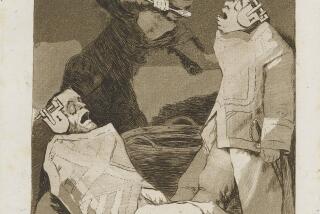THE COLLECTOR’S COLLECTION : Simon: First and Foremost, He Bought Art
Jean-Antoine Watteau’s “Reclining Nude” (circa 1713-1721) is a tiny painting, just over six inches wide and five high, but it’s the one I most look forward to seeing whenever I visit the Norton Simon Museum in Pasadena. Simon, who died Wednesday at 86, collected greater works--lots of them, in fact, since his collection ranks as the most extraordinary west of Chicago. But the Watteau has a special charm.
In fact, the amazing company it keeps only adds to its attraction. Staggering Northern Renaissance pictures by Dieric Bouts, Hans Memling, Gerard David, Lucas Cranach and others claim a particular distinction, so difficult is it to acquire such an august assembly.
Nor is Italy shabbily represented, with a limpid “Madonna and Child With a Book” by Raphael or an extravagant “Flight Into Egypt” by the Mannerist genius Jacopo Bassano, among the many works that would fit seamlessly within any of the world’s greatest museums.
The Bassano may be the artist’s greatest painting. Francisco de Zurbaran’s “Still Life With Lemons, Oranges and a Rose” may be the Spaniard’s greatest painting. Several of Edgar Degas’ greatest bronzes are surely in the collection, since the Simon Museum owns casts of almost all he ever made.
I could go on. Paolo Veneziano. Pietro Lorenzetti. Filippino Lippi. Rembrandt. Manet. Van Gogh.
Spectacularly good paintings by them all. There are wonderful 20th-Century pictures, too, by Henri Rousseau, Ernst Ludwig Kirchner, Picasso, Liubov Popova and others--not to mention exceptional sculptures by Brancusi. With some 12,000 works in the collection, including an outstanding array of Indian and Southeast Asian sculpture, it’s impossible to list even a representative sample.
Norton Simon began to collect art only in the mid-1950s, and within a dozen years he had become the single most important American collector of our time. As the collection developed, he joined the rarefied ranks occupied by perhaps only one other, Switzerland’s Baron Thyssen-Bornemisza.
The Thyssen collection has lately ended up as part of Madrid’s legendary Prado Museum. The Simon Museum is expected to remain in Pasadena--although, like Thyssen, Simon did have discussions with the J. Paul Getty Trust concerning a possible merger. Speculation on that front was fueled in the 1980s, when the Simon and the Getty jointly acquired Nicolas Poussin’s classically austere “Holy Family With the Infant St. John the Baptist and St. Elizabeth” and Degas’ grave and poignant pastel “Waiting.”
Of course, Simon had courted many suitors over the years. He famously feuded with the L.A. County Museum of Art, where his holdings had been on loan, forming the nucleus of an anticipated collection for the young museum--but he abruptly pulled out. He later dangled part of the collection before the then-mayor of San Francisco, Dianne Feinstein; it, too, came to naught.
When a press conference was called at UCLA in 1987 to announce the “imminent” gift of the collection to the university, only the most gullible believed it. The boy had cried wolf once too often, and the move was seen as a public lever in private negotiations with the Getty.
Simon could certainly be cantankerous and manipulative. His bargain-basement offer to rescue the financially bankrupt Pasadena Museum of Modern Art, which he immediately stacked with a hand-picked board of obliging trustees and turned into a repository for his own collection, was often likened to a corporate takeover. The museum’s contemporary art largely disappeared into the basement, and its great Galka Scheyer collection of modern work by Paul Klee, Wassily Kandinsky, Lyonel Feininger and Alexej Jawlensky was not always given the prominence it merits.
Still, what Simon installed in the awkward galleries of the badly designed building could easily take your mind away from all that--even take your mind away from the awful architecture of the building you were in.
To this day it is startling to walk into the museum and be reminded, once again, how extraordinary the collection is. It’s nearly inconceivable that a single person, working over the course of about 25 years in the postwar era, could assemble such a magnificent array.
How did Simon do it? By facing two things few others often manage.
First, he was not afraid to spend the money he had made. Second, he was not afraid to spend it to buy pictures by artists whose names might be obscure-- if the painting at hand was great.
The Zurbaran and the Bassano are examples of works that hold their own among the very stiffest competition, even though the artists, taken as a whole, are not of the very first tier. There are countless examples of amazing pictures by artists better known to specialists: Guariento di Arpo, Giovanni di Paolo, Juan Rexach, Francesco Raibolini, Guido Cagnacci and more.
Yes, Simon bought “names,” too. First and foremost, however, he bought art.
That’s part of the reason the little Watteau knocks me out. Painted when the artist was about 30, the boudoir picture shows a female nude luxuriously reclining on creamy white sheets before an auburn background. She’s just lifted her head, as if someone (her lover?) had slipped into her chamber.
Watteau has painted the image with a light, feathery touch. Visually, it’s as if he was squinting through gauze or seeing her through sleepy eyes. An undeniably erotic charge is met by a gentle dreaminess that borders on melancholy, as the artist simultaneously acknowledges the exquisite pleasures of the flesh and their fleeting transitoriness.
This may not be a classically “major painting.” Yet, its few square inches are everything you’d want in a painting by Watteau--and Norton Simon knew it.
More to Read
The biggest entertainment stories
Get our big stories about Hollywood, film, television, music, arts, culture and more right in your inbox as soon as they publish.
You may occasionally receive promotional content from the Los Angeles Times.











